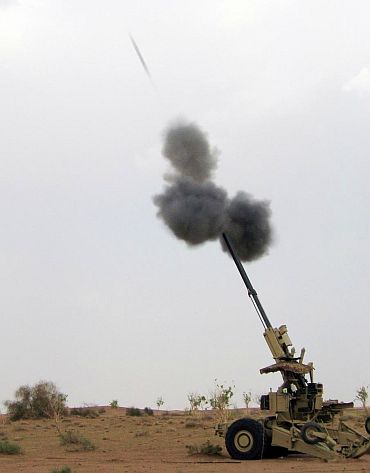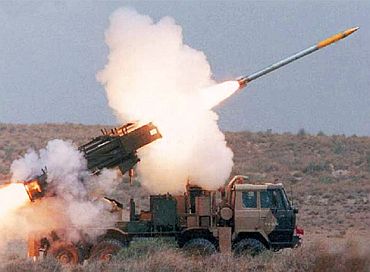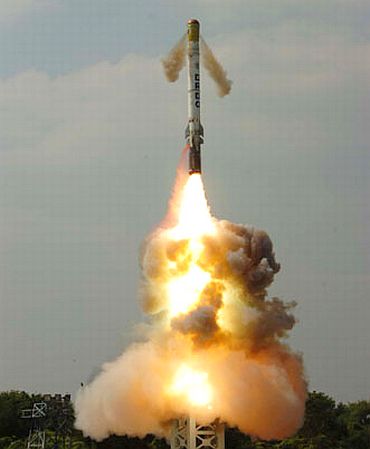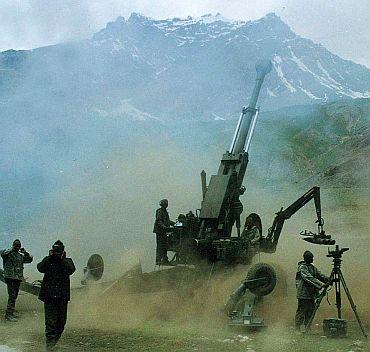Ajai Shukla in New Delhi
India's indigenous defence complex is at a crucial moment where a resolute decision could make it a genuine supplier of high-end artillery equipment, writes Ajai Shukla
In adversity, the saying goes, lies opportunity. Applying that principle, India's indigenous defence complex is at a crucial moment where a resolute decision could make it a genuine supplier of high-end artillery equipment, instead of a mere spectator to a global shopping spree by the Indian military.
Last Friday, the Ministry of Defence signalled (if confirmation were needed) that it lacks the political will to cast aside the procedure in selecting a 155-millimetre artillery gun for the army.
With the CBI proceeding against Singapore Technologies Kinetic (STK), one of the two remaining companies in the fray, the MoD restarted the entire process of tendering and trials rather than awarding the contract to the sole vendor remaining, UK-headquartered BAE Systems, which offered the politically contentious Bofors gun.
It is time to end this long-playing farce of trial and rejection and put the MoD and global vendors of artillery systems out of their misery. ...
India has the skills for building a 155-mm artillery gun
The Indian Army must be frankly told that it will receive no 155-mm guns for the next five-to-seven years. And a predominantly Indian consortium must be brought together to build an Indian gun within that period.
There are systems that remain beyond the capability of India's defence establishment. Aircraft engines, even tank engines, have proven too complex for India to develop.
The DRDO has also been unable to produce world-class night-vision devices; electro-optic sensors; and electronically scanned radars.
But India's growing technological capability has given it the capability to take on projects that were unthinkable two decades ago: fourth-generation fighters; advanced warships; even a tank with a gun that has proven to be world class.
India has the skills for building a 155-mm artillery gun; leadership is needed to bring them together.
The DRDO, increasingly sophisticated and technologically capable, is yearning to harness the proven manufacturing skills of India's private sector.
Global majors are willing to put money and muscle
Global majors like Bharat Forge and L&T are straining at the leash, willing to put money and muscle into what they have identified as a promising business vertical.
The Pinaka multi-barrelled rocket launcher (MBRL) has already proven how effectively the DRDO can leverage the private sector's manufacturing skills.
A state-of-the-art system, with electronics that are superior to even Russian frontline MBRLs, a single Pinaka regiment can obliterate a target 40 km away by pouring down 72 rockets onto it in just 44 seconds.
The DRDO's choice of L&T and Tata Power as industrial partners in the Pinaka project ensured that a quality design was enhanced by skilled manufacture.
Have faith on the DRDO
In the past, poor manufacturing practices, especially those of the public sector Ordnance Factory Board, had tarnished the reputation of otherwise well-designed DRDO products like the 5.56-mm INSAS rifle.
The MoD must bring together a public-private consortium, forming a joint venture (JV) -- call it, for now, the Indian Artillery Project -- in which the DRDO, the Indian Army, and the prime private sector participants have financial stakes.
The structure of the JV must allow for quick and flexible decision-making, without crippling regulations that mandate multi-vendor tendering and L-1 (lowest cost) procurement.
And, most importantly, a project management group must be drawn from the IAP partners to set and monitor timelines ruthlessly.
The army will understandably resist this project, being desperately short of artillery and wanting guns.
... the soldiers will come around
The most crucial component of combat capability, artillery guns -- firing high explosive shells at faraway targets -- have caused three quarters of all battlefield casualties over the last century of wars.
But the soldiers will come around, given assurances about delivery within a clear time frame.
Their choice is a stark one: continuing trials of foreign guns with no light certain at the end of the tunnel; or an official moratorium of five-to-seven years, followed by the simplified procurement processes of indigenous equipment.
The army is also aware that an indigenous 155-mm gun can be integrated ground-up into the overarching Artillery Command, Control and Communications System (ACCCS) that networks artillery resources into a seamless whole.
If that is acceptable to the army, it must frame its requirements realistically, rather than demanding a system so advanced that it remains a dream.
If a range of 40 km will suffice tactically, it is self-defeating to hold up the project by asking for 50 km. The DRDO too, with its institutional love for living in the future, will have to be firmly pegged to the here and now.
The time for the Indian Artillery Project is now
Constituting and financing the Indian Artillery Project will be small change, given what the MoD plans to pay global vendors for the four different 155-mm guns that the army needs.
Multiple procurements are simultaneously unfolding under the MoD-sanctioned Artillery Modernisation Plan.
The tender for 1,580 towed guns is worth an estimated Rs 8,000 crore. Another tender for 140 ultralight howitzers for mountain formations is worth over Rs 3,000 crore.
Also being processed is a Rs 3,500 crore purchase of 100 medium guns, mounted on tracked vehicles, for India's mechanised forces. Another Rs 4,000 crore is earmarked for 180 vehicle-mounted guns for self-propelled regiments. The total money in play here is some Rs 18,500 crore.
The MoD's procurement procedures have a "Make" category, which has been envisioned for just such a project. The time for the Indian Artillery Project is now.








article